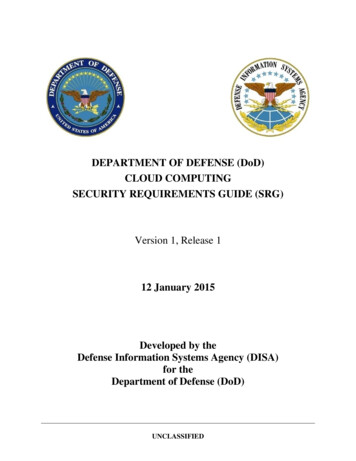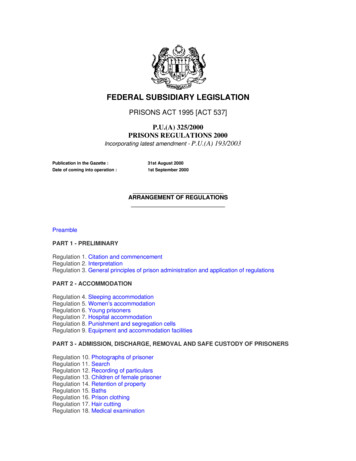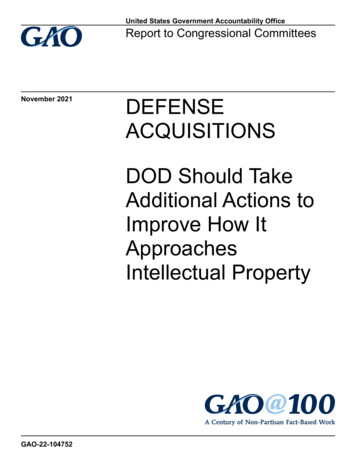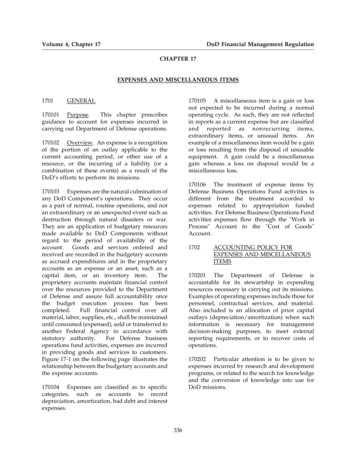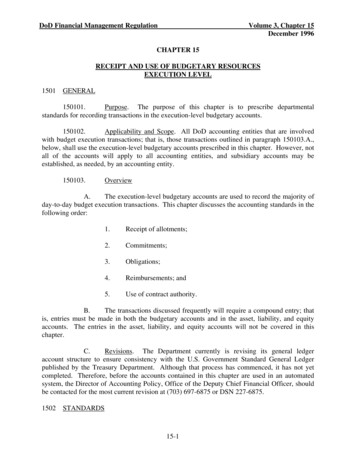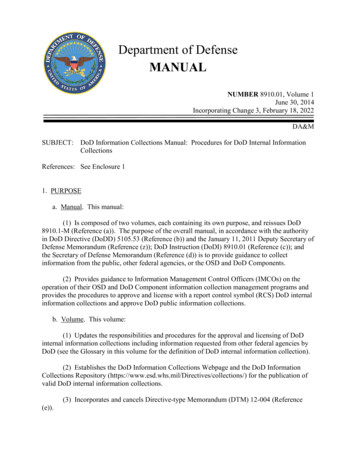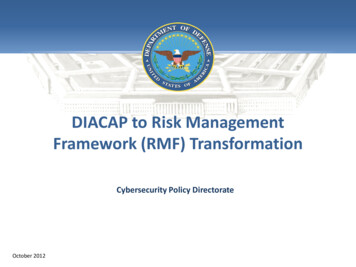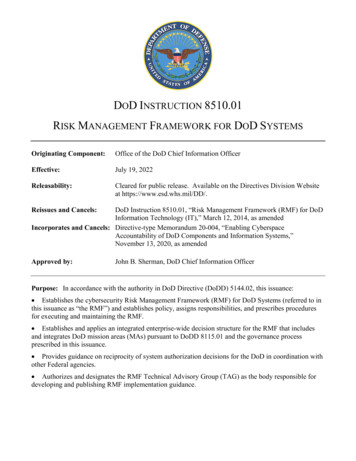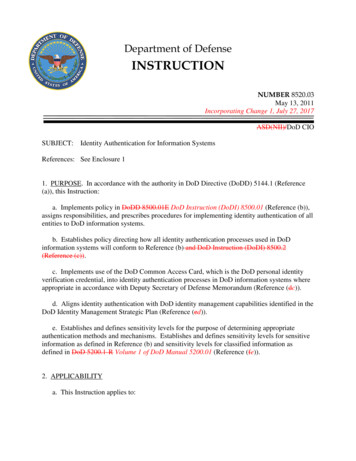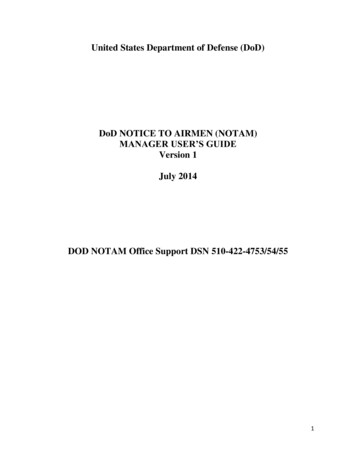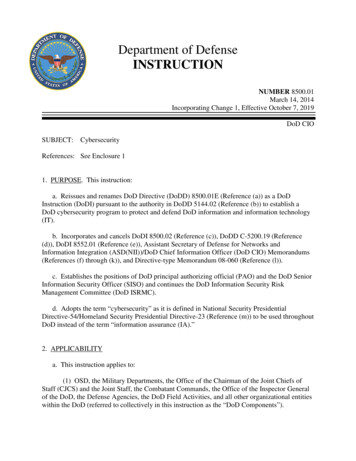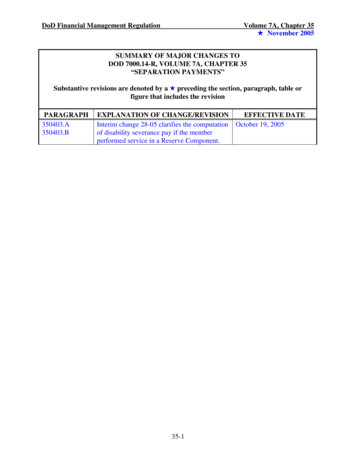
Transcription
DoD Financial Management RegulationVolume 7A, Chapter 35 November 2005SUMMARY OF MAJOR CHANGES TODOD 7000.14-R, VOLUME 7A, CHAPTER 35“SEPARATION PAYMENTS”Substantive revisions are denoted by a preceding the section, paragraph, table orfigure that includes the revisionPARAGRAPH350403.A350403.BEXPLANATION OF CHANGE/REVISIONEFFECTIVE DATEInterim change 28-05 clarifies the computation October 19, 2005of disability severance pay if the memberperformed service in a Reserve Component.35-1
DoD Financial Management RegulationVolume 7A, Chapter 35 November 2005TABLE OF CONTENTSSEPARATION PAYMENTS3501Accrued Leave Pay3502Separation Pay (Nondisability)3503Savings Provisions for Readjustment and Severance Pay (Other than Disability)3504Disability Severance Pay3505Contract Cancellation Pay and Allowance (Navy and Marine Corps Only)3506Miscellaneous Separation Payments3507Special Separation Benefit3508Voluntary Separation Incentive35-2
DoD Financial Management RegulationVolume 7A, Chapter 35 November 2005CHAPTER 35SEPARATION PAYMENTS3501ACCRUED LEAVE PAY350101.General EntitlementA.A member who is discharged under honorable conditions is entitled topayment of unused accrued leave unless the member continues on active duty under conditionsthat require accrued leave to be carried forward. An enlisted member who voluntarily extendstheir enlistment for the first time is also entitled to payment for unused accrued leave.1.Conditions for Payment of Unused Accrued Leave.SeeTables 35-1 through 35-4 for specific rules governing whether a member may be paid for unusedaccrued leave.2.Career Leave Payment Limitation of 60 daysa.Effective February 10, 1976, a military member is entitledto receive payment for no more than 60 days of accrued leave during a military career.Payments for unused accrued leave made before that date shall be excluded from this 60-daylimitation.b.Effective July 14, 1976, a military member eligible for anunused accrued leave settlement is authorized an election with regard to payment or carry-overof the leave. The member may elect to receive payment for a portion of the unused leave, not toexceed a career total of 60 days, and to have the remaining accrued leave carried forward to anew or extended enlistment. The total of paid and carried forward leave may exceed 60 days.3.Exceptions to the 60 Day Career Leave Payment Limitationa.Contingency Operations. The 60-day leave paymentlimitation does not apply with respect to leave accrued by a member of a reserve component orin the Retired Reserve or by a retired member of the Regular Army, Regular Navy, Regular AirForce, or Regular Marine Corps or a member of the Fleet Reserve or Fleet Marine Corps Reserveduring any period while the member also is:(1)Serving on active duty in support of a contingencyoperation on or after December 5, 1991, or(2)Serving on active duty in connection with thePersian Gulf conflict (other than for training) under authority of Title 10, U.S.C. Sections 672,688, 12302, 12304, 12306 or 12307 on or after August 2, 1990.35-3
DoD Financial Management RegulationVolume 7A, Chapter 35 November 2005b.Active Duty of 31 to 365 Days. The 60-day leave paymentlimitation does not apply with respect to leave accrued by a member of a reserve componentwhile serving on active duty, full-time National Guard duty, or active duty for training during aperiod of more than 30 days, but not in excess of 365 days, beginning on or afterOctober 1, 2001.c.Death on Active Duty. The 60-day leave paymentlimitation does not apply with respect to leave accrued by a member who dies while on activeduty (or a member or former member who dies after retirement or discharge, but before receivingpayment of accrued leave). Payment of accrued leave for a deceased member is based upon theunused accrued leave that he or she carried forward into the leave year in which deceased plusthe unused leave that accrued during that leave year, beginning on or after February 10, 1996.d.Career Leave Payment Total. Unused leave accruedspecifically under the conditions of subparagraphs a through c, above, is additional to themember’s career leave payment limitation of 60 days. Such unused excepted leave may becarried forward into a new contract period of active duty and later be eligible for payment inaddition to other leave to which the 60-day career ceiling applies. See paragraph 350102, below,for rules that apply to accounting for accrued and used leave and paragraph 350103, below, forcalculating the payment amount and the possible application of the combat zone tax exclusion.Example 1: On January 1, 2001, a National Guard member on activeduty under Title 32, U.S.C. (reference (bq)), for 3 years is mobilized with his unit under10 U.S.C. 672 (reference (c)). Although previously paid for career leave of 48 days, the memberhas elected to carry forward all 32 days of accrued unused leave from the pre-mobilizationperiod. On April 6, 2001, he is discharged and immediately ordered to active duty for anotherperiod of 3 years. The member used leave from April 2 through 5, 2001, (4 days). He has36 days accrued unused leave at discharge (32 days from his balance brought forward, plus8 days accrued under the mobilization, minus the 4 days leave used). He may elect to be paid fora maximum of 16 days leave at discharge which includes the 12 days up to the 60 day limitation,plus 4 days of excepted leave (earned 8 days of excepted leave less the 4 days used). Theremaining balance of 20 days (or more, if he takes payment for less than the full 16 days ofleave) may be carried forward into the new active duty period. If payment is made for 12 or lessdays, 4 days of the carry-over are an exception to the 60-day payment limitation and may be paidin the future, if they remain unused.B.Under regulations prescribed by the Secretary of the Military Departmentconcerned, a member sentenced to unsuspended dismissal or unsuspended dishonorable or badconduct discharge by court-martial may be required to take leave pending review of theconviction (i.e. appellate leave) as provided by Article 76a, Uniform Code of Military Justice(reference (i)). Such member may elect to be paid in a lump sum for the leave accrued to his orher credit as of the day before the day the leave begins. Otherwise, each day of appellate leaveshall be charged as a day of leave and the member paid accordingly until all the member’saccrued leave is used. Payment shall be based on the rate of basic pay to which the member wasentitled on the day before the day leave is to begin.35-4
DoD Financial Management RegulationVolume 7A, Chapter 35 November 2005C.A member who is discharged under other than honorable conditions orbecause of fraudulent enlistment forfeits all accrued leave at the time of discharge and is notentitled to payment for accrued leave, regardless of the length of time the separated member hasserved.D.A member who is enlisted or commissioned on or after October 19, 1984,and is discharged for unsatisfactory performance or misconduct for any of the reasons listedbelow forfeits all accrued leave at the time of discharge. Such forfeiture also applies to anymember with prior military service who had a break in service of 93 or more consecutive days:1.Enlisted members forfeit leave at discharge for the followingreasons:a.Defective enlistment or induction (minority and fraudulentb.Entry level performance and conduct.c.Unsatisfactory performance.d.Homosexuality (unless the member receives an honorablee.Drug/alcohol abuse rehabilitation failure.f.Misconduct.g.Separation in lieu of trial by court-martial.h.Security (unless the member receives an honorableentry only).discharge).discharge).2.Officers forfeit leave at discharge for the following reasons:a.Separation for cause.b.Dropped from the rolls.c.Homosexuality (unless the member receives an honorabled.Misconduct/moral/professional dereliction.e.Separation in lieu of trial by court-martial.discharge).35-5
DoD Financial Management Regulationf.Volume 7A, Chapter 35 November 2005Security (unless the member receives an honorabledischarge).350102.Leave AccountingA.Accrued leave must be carefully accounted for and accurately identified asto the time and circumstances under which it was earned. The number of days accrued and valueof unused leave that is to be sold depends upon the timeframe and circumstances under which itwas earned.1.Leave accrued on or before August 31, 1976, is valued using basicpay, basic allowance for housing, basic allowance for subsistence and, if applicable to theindividual, the personal money allowance. This leave is generally called “saved leave”.2.Leave earned on or after September 1, 1976, is valued using onlybasic pay.3.Leave accrued in a combat zone or qualified hazardous duty areaor while hospitalized as a result of action in such a zone or area is generally known as combatzone tax exclusion (CZTE) leave. See paragraph 440103 of this volume for full descriptions ofthe circumstances under which such leave accrues. CZTE leave for enlisted members is exemptfrom federal income tax. CZTE leave for officers is exempt from federal income tax up to aspecified limit. See paragraph 350103.B below, for a discussion of tax exclusion limits. Allleave earned during a month in which a member serves for any period of time in a combat zoneor qualified hazardous duty area is CZTE leave. A single day of qualifying service in suchcircumstance qualifies all leave accrued in that month as CZTE leave.B.Leave accrues to a service member serving on active duty for 30 days ormore. It is accrued at the rate of 2½ days for each month of active service, excluding periods ofabsence from duty without or over leave, periods of confinement resulting from courts-martialand periods of leave required to be taken pending review of court-martial conviction. For partialmonths, it accrues at the rate of ½ day for any period of 6 or less days. A member may not carryforward a leave balance of more than 60 days into a new fiscal year, except when entitled toSpecial Leave Accrual (SLA), as outlined below.1.A member who serves on active duty while entitled to hostilefire/imminent danger pay for a continuous period of at least 120 days may carry forward up to90 days of leave into the new fiscal year. Under this exemption, unused leave may be carriedforward until the end of the third fiscal year following the fiscal year in which the service in thequalifying hostile fire/imminent danger area is terminated.2.A member not qualifying for SLA for service in a hostilefire/imminent danger area, may, after September 30, 1979, qualify and carry forward up to90 days of unused leave by reason of assignment to a designated deployable ship, mobile unit, orother similar prescribed duty. The duty assignment must be under conditions where operationalmission requirements prohibit normal leave utilization as determined by the military service35-6
DoD Financial Management RegulationVolume 7A, Chapter 35 November 2005concerned or designated commander. Under this exemption, unused SLA leave may be carriedforward until the end of the third fiscal year following the fiscal year in which the qualifyingservice is terminated.3.The maximum amount of leave that may be carried forward intosucceeding fiscal years is the leave balance (not to exceed 90 days) as of the end of the SLAperiod. However, the maximum amount will be reduced to a new level whenever the leavebalance drops below the previously set level. If at any time, the leave balance drops to or goesbelow 60 days, there is no longer any SLA protected leave. Therefore, the actual maximumleave that can be carried forward into succeeding fiscal years is the lowest leave balanceachieved following the completion of the SLA duty or the usual 60 days, whichever is greater. Ifthe SLA qualifying period crosses a fiscal year, the entire leave balance (not to exceed 90 days)will be carried forward and the leave accrued from the beginning of the new fiscal year throughthe end of the SLA qualifying period will be added to establish the maximum. Notwithstandingthe above, any portion of a leave balance in excess of 60 days which could have been takenbefore the end of the fiscal year, had the member not been assigned to SLA qualifying duty, willnot be included in the carry over amount.Example 1: On August 31, 2001, a member had a leave balance of80 days. On September 15, 2001, he was assigned to duty qualifying for SLA as described insubparagraph 350102.B.1, above. Had the member not been assigned to SLA duty, he couldhave possibly taken 15 days leave from September 16 through 30. If the member had takenleave during this period, there would still have been a loss of 7.5 days (82.5 days accruedthrough September 30 less the 15 days potentially taken and the normal 60-day carry-overrestriction) at the end of the fiscal year. Therefore, since only the portion that potentially couldhave been taken is protected, the member may carry forward 75 days and will lose 7.5 days ofleave.Example 2: The member in example 1 above, continued on SLA dutyuntil January 31, 2002. No leave was permitted during this period and the member’s accruedleave totaled 85 days at the end of January. If the leave balance does not at any time drop below85 days it may be carried forward for 3 fiscal years, until September 30, 2005. However, themember took 30 days of leave from April 1 through 30, 2002. This resulted in a leave balance of62.5 days (85 days accrued through January, plus 7.5 days accrued from February through April,less the 30 days of leave taken) and a new maximum amount of leave that may be carriedforward. If no further SLA is earned and the leave balance is not further reduced to a new lowerlevel, the maximum leave the member may carry forward into succeeding fiscal years (untilSeptember 30, 2005) is 62.5 days.C.Leave will be accounted for by crediting it sequentially in thechronological order in which it is accrued. Generally when used, leave will be charged inreverse order with the most recently accrued leave charged first. This method is known as LastIn, First Out (LIFO). As an exception to this method, beginning January 1, 1996, CZTE leavewill be charged ahead of all other leave, regardless of the sequence in which the CZTE leave wasaccrued.35-7
DoD Financial Management RegulationVolume 7A, Chapter 35 November 2005Example 1: On August 31, 2001, a member had accrued 65 days ofunused leave, 55 days of which had been accrued and remained unused from a period beforeSeptember 1, 1976 (i.e., saved leave), and zero days of tax exempt leave. The member tookleave from September 5 through 24, 2001, a period of 20 days. The leave taken is first applied tothe 12 days accrued since September 1, 1976, using the LIFO method. This leaves 8 days toapply to the saved leave, reducing that balance to 47 days.Example 2: On August 31, 2001, a member had accrued 75.5 days ofunused leave, 55 days of which had been accrued and remained unused from a period beforeSeptember 1, 1976 (i.e., saved leave), and 7.5 days of accrued unused CZTE leave. The CZTEleave had been earned for two separate periods, 5 days for active service from January 2 throughFebruary 6, 2001 in a combat zone and 2.5 days for active service fromAugust 7 through 30, 2001, in a qualified hazardous duty area. The member took leave fromSeptember 5 through 24, 2001, a period of 20 days. The leave taken is first applied to the7.5 days of CZTE leave, using the exception to the LIFO method. This leaves 12.5 days to beapplied to the non-CZTE leave earned since September 1, 1976, reducing that balance to 2.5days as of September 24, 2001. The saved leave balance remains at 55 days.350103.Leave Payments and TaxabilityA.Payments for accrued leave are normally subject to taxation and incometax withholding. However, payments for saved leave accrued before September 1, 1976, willalso include non-taxable allowances. See Table 35-5 for determining the elements of pay to usein the computation of accrued leave payments.B.Payments for CZTE leave are tax exempt from federal taxation and notsubject to federal or state income tax withholding up to the monthly limit specified by theInternal Revenue Service. That limit is different for enlisted members and officers. The limit isfully described in Chapter 44, paragraph 440102.A, of this volume, as summarized below.1.Enlisted members (E-1 and above) and warrant officers (W-1through W-5) have no limitation or ceiling on the value of payments exempt from federal taxesor from state and federal tax withholding for any month in which they qualify for an exemption.2.Officers (O-1 and above) are subject to a limit on the value offederal tax exempt payments and from exemption from federal and state tax withholding for eachmonth in which they qualify for an exemption. Since November 21, 1995, the exemptionamount for officers has been set at the value of the highest rate of enlisted basic pay plus thevalue of any hostile fire or imminent danger pay the officer may have been entitled to in thatqualifying month. The applicable rate of enlisted basic pay would be that listed in Chapter 1,Table 1-10, Note 2 of this volume, for the corresponding qualifying month. To determinewhether the limitation will apply to a payment for accrued unused leave, the leave must beallocated to the months in which earned and for which the officer qualified for CZTE status. Thevalue of the leave for each individual month must be added to any payments the officer hasreceived for that tax exempt month and the total compared to the monthly limitation amount.Tax exemption may only be given for the value of that portion of the CZTE leave that does not35-8
DoD Financial Management RegulationVolume 7A, Chapter 35 November 2005exceed the limitation available. Any payments for CZTE leave value that exceed the limitationavailable will be treated as taxable income.Example: A Reserve Component O-5 with over 12 years service beganactive duty on January 25, 2002, and reported temporary additional duty to a designated combatzone on January 26, 2002. He departed the zone on March 2, 2002, and was separated fromactive duty and paid for unused accrued leave on March 4, 2002. The officer was entitled tomonthly basic pay of 5073.30 and to monthly imminent danger pay of 150. The monthly basicpay for the most senior enlisted member in each military service was 5382.90 per month duringthat period. The officer has been paid for his active duty service and is awaiting payment for hisearned leave. He had previously sold back 58 days of leave at the end of other active dutyperiods. The officer earned .5 days of leave in January and again in March and 2.5 days forFebruary. This is a total of 3.5 days leave and when added to the 58 days previously sold, wouldexceed the maximum of 60 days that may be sold in a career. However this leave is exempt frompayment limitation since the reserve officer was on active duty for a period of more than 30, butless than 366 days. Payment of the .5 days of leave for both January and March is fully exemptfrom income tax and income tax withholding since the prior tax free payments for his basic payand hostile fire/imminent danger pay in those 2 months was well below the tax exemptionlimitation value of 5532.90 (senior enlisted basic pay of 5382.90 and hostile fire/imminentdanger pay of 150). However, only a portion of the 2.5 days of unused accrued attributable toFebruary is exempt from income tax and income tax withholding. The officer has alreadyreceived tax exempt treatment of his February salary and imminent danger pay using all but 309.60 of his available exemption (exemption equals 5532.90 and the amount used was theofficer’s base pay plus the hostile fire/imminent danger pay or 5223.30). The 2.5 days of leaveis valued at 422.78, leaving 113.18 of the leave payment subject to tax and tax withholding.350104.Leave Payments and Debts. Payments for accrued leave may be used tosatisfy debts to the U.S. Government without restriction.350105.Leave Payment to Beneficiaries. Payments for accrued leave owed atdeath will be paid to the eligible beneficiary or beneficiaries under the provisions of Chapter 36,Section 3602, of this volume.A.If a member dies while on active duty of 30 days or more, the accruedleave is payable along with all other unpaid pay and allowances to the eligible beneficiary.B.If a member or former member dies after retirement or discharge, butbefore receiving any or all compensation for accrued leave, the balance is payable to the eligiblebeneficiary and claims for payment must be submitted to the appropriate below listed address.35-9
DoD Financial Management RegulationVolume 7A, Chapter 35 November 2005Army MembersDirectorDFAS-Indianapolis SiteDFAS-PMTEC/IN8899 E. 56th StreetIndianapolis, IN 46249-0845Navy MembersDirectorDFAS-Cleveland SiteDFAS-PMMACB/CL1240 E. 9th StreetCleveland, OH 44199-2055Air Force MembersDirectorDFAS-Denver SiteDFAS-PMJP/DE6760 E. Irvington PlaceDenver, CO 80279-3000Marine Corps MembersDirectorDFAS-Kansas City SiteDFAS-PMMCB/KC1500 E. 95th StreetKansas City, MO 64197-00013502SEPARATION PAY (NONDISABILITY)350201.EntitlementA.Full Separation Pay. Beginning on June 20, 1991, full payment ofnondisability separation pay has been authorized to Military Service members of the Regular andReserve Components who have been involuntarily separated from active duty and have met eachof the following four conditions:1.The member has met one of the following criteria for activemilitary service:a.The member is on active duty or full-time National Guardduty and has completed at least 6 years, but less than 20 years, active service. Reserve membersnot on the active duty list when separated must have 6 years of continuous active duty orfull-time National Guard duty immediately preceding separation. A period of active duty isconsidered continuous if any break in active service does not exceed 30 days.b.The member (other than a regular enlisted member) was on35-10
DoD Financial Management RegulationVolume 7A, Chapter 35 November 2005active duty or full-time National Guard duty on November 5, 1990, and on that date had 5 ormore, but less than 6, years of active service. Reserve members not on the active duty list whenseparated must have 5 years of continuous active duty or full-time National Guard dutyimmediately preceding separation. A period of active duty is considered continuous if any breakin active service does not exceed 30 days.c.Effective December 1, 1993, a member who is a Regularofficer and is separated under chapter 36 of 10 U.S.C. (reference (c)) (except under sections630(1)(A) or 643 of such chapter (reference (c))) or under 10 U.S.C., 580 or 6383 of (reference(c)) must have completed at least 6 years, but less than 20 years, of active service.d.The member, who is a Regular officer and is separatedunder chapter 36 of 10 U.S.C. (reference (c)) (except under sections 630(1)(A) or 643 of suchchapter (reference (c)), or under 10 U.S.C., sections 580 or 6383 (reference (c)), must havecompleted 5 or more years, but less than 6 years, of active service on November 30, 1993.2.The member’s separation must be characterized as “honorable”and none of the conditions apply that are listed in paragraph 350202, below.3.A member who is separated involuntarily through either the denialof reenlistment or the denial of continuation on active duty or full-time National Guard dutymust meet one of the following four specific conditions:a.The member must be fully qualified for retention but bedenied reenlistment or continuation. This includes a Military Service member who is eligible forpromotion as established by the Secretary of the Military Service concerned, but is deniedreenlistment or continuation on active duty under established promotion or high year of tenurepolicies.b.The member must be fully qualified for retention, but beinvoluntarily separated under a Reduction in Force by authority designated by the Secretary ofthe Military Service concerned.c.The member, if a Regular officer, commissioned orwarrant, must be separated under 10 U.S.C. 564, 1165, or 6383, or chapter 36 (reference (c)); if aReserve commissioned officer, other than a commissioned warrant officer, must be separated ortransferred to the retired Reserve under 10 U.S.C., chapters 361, 363, 573, 861, or 863 of(reference (c)); or if a Reserve commissioned officer on the active duty list or a Reserve warrantofficer must be separated for similar reasons under Military Service policies.d.The member must be denied reenlistment or continuationon active duty or full-time National Guard duty under subparagraphs 350201.A.3.a through c,above, and have accepted an earlier separation from active duty.35-11
DoD Financial Management RegulationVolume 7A, Chapter 35 November 20054.The member must have entered into a written agreement with theMilitary Service concerned to serve in the Ready Reserve of a Reserve Component of the ArmedForces for a minimum period of 3 years following the separation from active duty.a.A member who enters into this written agreement and whois qualified for service in the Ready Reserve will, upon separation from active duty, be enlistedor appointed, as appropriate, as a Reserve member by the Military Service concerned. If theperson has a service obligation under of 10 U.S.C. 651 (reference (c)), or any other law, that isnot completed at the time of separation from active duty, the 3-year obligation begins on the dayafter the day on which the member completes the prior obligation.b.A member who enters into this written agreement and whois not qualified for enlistment or appointment in the Ready Reserves need not be enlisted orappointed by the Military Service concerned to be considered to have met this condition ofeligibility for separation pay.B.Half Separation Pay. Beginning on June 20, 1991, half payment ofnondisability separation pay has been authorized to Military Service members of the Regular andReserve Components who involuntarily have separated from active duty and who have met eachof the following four conditions: (Note: In extraordinary instances, the Secretary of the MilitaryService concerned may award full separation pay to a member otherwise eligible for halfseparation pay when the specific reasons for the separation and the overall quality of themember’s service have been such that denial of full separation pay would be clearly unjust.)1.The member must meet one of the criteria for active servicespecified in subparagraph 350201.A.1, above.2.The member’s separation must be characterized as “honorable” or“general,” and none of the conditions apply that are listed in paragraph 350202, below.3.The member must be separated involuntarily by the MilitaryService concerned through either the denial of reenlistment or the denial of continuation onactive duty or full-time National Guard Duty under one of the following specific conditions:a.The member is not fully qualified for retention and isdenied reenlistment or continuation under any of the following conditions:(1)Expiration of service obligation.(2)Selected changes in service obligation.(3)Convenience of the government.(4)Homosexuality.(5)Drug abuse rehabilitation failure.35-12
DoD Financial Management RegulationVolume 7A, Chapter 35 November 2005(6)Alcohol abuse rehabilitation failure.(7)Security.(8)Weight control failure.b.The member must be separated under a Military Servicespecific program established as a half payment level by the Secretary of the Military Serviceconcerned.c.The member must be denied reenlistment or continuationon active duty or full-time National Guard duty under subparagraphs 350201.B.3.a and b, above,and accept an earlier separation from active duty.4.The member must have entered into a written agreement with theMilitary Service concerned to serve in the Ready Reserve for a minimum period of 3 yearsfollowing separation from active duty.a.A member who enters into this written agreement and whois qualified for the Ready Reserve will, upon separation from active duty, be enlisted orappointed, as appropriate, as a Reserve member by the Military Service concerned. If the personhas a service obligation under 10 U.S.C. 651 (reference (c)), or any other law, that is notcompleted at the time of separation from active duty, the 3-year obligation begins on the dayafter the day on which the member completes the prior obligation.b.A member who enters into this written agreement and whois not qualified for enlistment or appointment in the Ready Reserve need not be enlisted orappointed by the Military Service concerned to be considered to have met this condition ofeligibility for separation pay.350202.Limitations of Eligibility. Military Service members separated under thefollowing circumstances are not eligible for separation pay:A.The member is separated from active duty at the member’s own request.The following are considered to be separations at the member’s own request.1.A member declines training that the Military Service offers toqualify for a new skill or rating as a precondition to reenlistment or continuation on active duty.2.A member requests separation under regulations established by theSecretary of the Military Service concerned as provided for in DoD Directives 1332.14(reference (bs)) and 1332.30 (reference (bt)).3.A Reserve officer declines a Regular appointment at the mandatoryintegration point, when an all-regular career force program is implemented by the Secretary35-13
DoD Financial Management RegulationVolume 7A, Chapter 35 November 2005concerned.B.The member is separated from active duty during an initial term ofenlistment or an initial period of obligated service. The initial term of enlistment or initial periodof obligated service is the active service obligation that the member incurred upon initialenlistment or upon enrollmen
DoD Financial Management Regulation Volume 7A, Chapter 35 November 2005 b. Active Duty of 31 to 365 Days. The 60-day leave payment limitation does not apply with respect to leave accrued by a member of a reserve component
